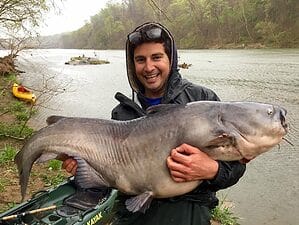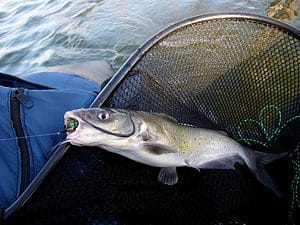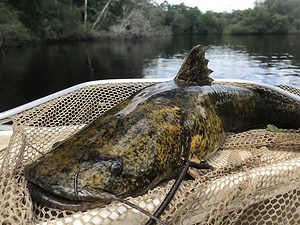Disclosure: Some posts contain affiliate links, which earn us a commission if you make a purchase through them. Positive Fishing © participates in various affiliate networks including the Amazon Services LLC Associates Program.
Across the United States, anglers of all skill levels hold catfish in high regard. They’re a major part of the history of the country. Native Americans targeted them for their delicious meat and strong bones. Today, sport anglers love the challenge of landing these fish. The numerous ways of targeting them and their massive populations make for an always entertaining day on the water!
In this article, let’s cover the three primary catfish species found across the United States, where to find them, and of course, how to fish for them!
Types Of Catfish In The United States
Across the country, anglers will find three main catfish types: Blue Catfish, Channel Catfish, and Flathead Catfish. Catfish are often referred to as the “big 3.”
Catfish are apex predators of rivers, lakes, and tributaries. They stalk their prey and are opportunistic and generalist predators, mostly feeding on other fish.
Blue Catfish

Blue catfish are the largest of all the catfish in the United States and most sought after by trophy catfish anglers. The world record was caught by Richard Nicholas Anderson in 2011 in Kerr Lake, Virginia.
Blue Catfish Physical Characteristics
The main identifier for blue catfish is their bluish/grey color at all times in their development. As they grow older and larger, they often become a bit darker and can nearly turn black. They rarely ever have any spots on their bodies.
Another characteristic unique to blue catfish is the long, straight, flat anal fin. These often have somewhere between 30 and 36 rays! The final feature that sets blue cats apart is the four pairs of smaller whiskers (or barbels) around their mouths, which they have compared to channel and flathead catfish.
Blue Catfish Size And Lifespan
Blue catfish can grow upwards of 100 pounds! However, their average size is in the 20 to 40-pound range! They’re massive fish and the largest catfish in the United States.
An average size blue catfish of 20lbs is likely to be around 2 to 3 feet in length. A blue catfish of 100lbs is going to well exceed 4 feet in length!
They’re known to be hearty fish and can live for up to twenty years! The average lifespan for a blue catfish is around ten years.
Blue Catfish Diet
When Blue Catfish are young, they generally eat aquatic insects that are commonly found in United States bodies of water. They’ll eat caddisflies, Stoneflies, Mayflies, and any terrestrial patterns they can find.
As they grow older, the main diet of catfish is crustaceans and other small fish. Crayfish, mussels, worms, and freshwater shrimp are personal favorites of blue cats! Catfish are also unique in the sense that they aren’t afraid to eat dead fish. If there’s been a shad kill or other fish kill, catfish will eat the remains!
Blue catfish are voracious eaters; studies have shown they can eat 2 to 5% of their body weight in a single day!
Blue Catfish Habitat
Blue catfish live mainly through the Mississippi river drainage, which covers the Missouri, Ohio, Tennessee, and Arkansas Rivers. But can also be found in the Des Moines River in South Central Iowa and also the Rio Grande.
They follow moderate temperatures in the water. As the summer progresses, they’ll move north to find water that’s a bit cooler, and in the winter, they head south to find some warmer water!
They like fast currents, deep holes, and pools. Anywhere where sediment on the bottom is consistently stirred up and food flows, you’ll find catfish. It’s impressive to see where these fish are willing to sit! However, if it’s deep enough, they can get below some of the fastest-moving water and make their moves from there.
Blue Catfish Spawning
Blue catfish generally spawn one week after they have laid their eggs during late spring and early summer. The water temperature dictates the exact spawning time, which needs to be around 70° to 75°F. They don’t become sexually mature until they’re around two feet long and approximately 4 to 7 years old.
Channel Catfish

Channel catfish are another very common species found across the United States. Most experts would say that channel catfish have the highest population in the country! And they are the most commonly caught catfish by anglers in the US.
Channel Catfish Physical Characteristics
The main characteristics that separate a channel catfish from the other two species are their large upper jaw and heavily forked tail. Without these, they could look similar to both blue and flathead catfish.
Channel cats are more of a brown and tan color. Yes, they do sometimes have blue and grey shades, but their primary colors are brown and tan. Also, they’ll have black dots near the bottoms of these fish that generally disappear as they grow larger and older.
Their anal fins are also flat like blue catfish but have fewer rays, typically between 24 and 29.
Channel Catfish Size And Lifespan
The average channel cat is around 18 inches long and somewhere around four or five pounds! They are known to grow over 50 pounds in certain areas!
Channel catfish can live for up to 15 years! The average lifespan for a channel catfish is around 6 to 8 years. They’re typically around half the size of a blue catfish and have some of the same features.
Channel Catfish Diet
Similar to blue catfish, young channel cats will stick to aquatic insects and some crustaceans. Mayflies, midges, and caddis patterns are their most common options. As they mature, they move to smaller fish and crustaceans. They absolutely love crayfish and small suckers.
Like blue catfish, they aren’t overly picky about whether or not the fish are alive or recently dead! They won’t eat rotten fish, but recently deceased fish is a part of their menu.
Channel Catfish Habitat
Almost every lake, river, pond, and reservoir has a healthy population of catfish. They live on the bottom below the extremely harsh currents. Their flatter bodies allow them to pin themselves to the bottom of the water column and hide behind any structure waiting for fish. They don’t need much structure to hide away, waiting for any food sources.
Channel Catfish Spawning
The channel catfish spawn most often occurs in the late spring when the water reaches around 75 degrees! The males find the nests and create them in dark, secluded areas, and the females lay the eggs! After a week, they generally hatch.
Channel catfish will typically reach maturity at five years old.
Flathead Catfish

Flathead catfish are the third most common type of catfish that people find across the United States. They’re equally as impressive as the other two species!
Flathead Catfish Physical Characteristics
The Flathead Catfish gets its name from its flat head. While most other species of catfish also have a flathead, the Flathead Catfish itself has even more of a flat skull.
Flathead cats are easy to identify because they are yellow/brown in color. Some black and dark brown are mixed into their colorings! They’re unlike any other common catfish species in the United States.
Also, their tails only have a small fork in them compared to the large notch in blue and channel catfish.
Flathead Catfish Size And Lifespan
On average, flathead catfish can be upwards of 10-20 pounds and approximately 2 feet long! However, there have been flathead catfish that were caught and weighed in at over 100 pounds.
The average lifespan of the flathead catfish is typically around 12 to 14 years.
Flathead Catfish Diet
Flathead catfish primarily eat fish! They tend to be less of a scavenger hunter than the blue or channel catfish. From the spawn, they eat all types of fish, crustaceans, and any other meaty option in the water!
Flathead Catfish Habitat
Flathead catfish are lone rangers. They find a deep, secluded section of water and hang out on their own until it’s time to feed. Some common areas they live in are cut banks, under trees, or near large rocks. At night, Flathead Catfish move towards more shallow water and begin to feed.
Flathead Catfish Spawning
Flathead catfish spawn in the early summer. Female flathead catfish lay upwards of 1200 eggs for every single pound they weigh! These are massive numbers! There’s a reason catfish are some of the most highly populated fish in the world.
Where Can You Find Catfish?
Thankfully, catfish are arguably the most highly populated fish in the entire United States. The only other species with a similar or higher number is bass. The numbers contradict themselves as to what fish have more!
Blue catfish, channel catfish, and flathead catfish are found in all midwestern watersheds! The Mississippi and Missouri Rivers are two of the most common places that anglers find them. Any body of water attached to these rivers will also contain populations of all three.
Take a look at your state’s game and fish department or DNR website and see where these fish live! They’ll likely have an interactive map that shows different bodies of water where they’re found.
What Gear Is Needed for Catfish Fishing
Your catfish setup doesn’t have to be complicated! A traditional rod and reel with some heavy weights and a large hook are basically all you need. But those trophy catfish are likely to need some beefier setup to land them!
Best Catfish Rod
The ideal catfish rod is one that’s heavy. These fish are extremely strong, and you often feel as if you’re trying to drag in a massive rock. When they do decide to run, however, they go quickly, so you want to make sure whatever rod you choose has enough of a backbone to land upwards of a 50 to 100-pound fish.
Most anglers choose to use rods that are 6’ to 8’ long, depending on how long of casts you’re trying to make! If you’re on a boat, a 6’ rod is plenty! If you’re fishing from shore, stick with an 8’ rod.
Some anglers choose to go with medium-heavy rods because they enjoy feeling every single movement of the fish! If you know you’re primarily going to be landing 10-20 pound fish, that’s okay.
If you have a chance to catch upwards of a 50-pound cat, you want a heavy-power rod. These aren’t always the most sensitive rods but have the stiffness and power to fight a fleeing cat.
Try the Berkely Shock rod or the Ugly Stik Catfish Rod from Shakespeare! These are more suited for catfish fishing, and both going meet the demands of even the biggest specimen catfish.
Best Catfish Reel
For your reel, you first want to make sure it matches your rod. Secondly, you want to make sure it has enough power to horse in one of these fish. The drag system needs to be extremely strong. Again, when you’re fishing catfish, they don’t always make long runs, but when they do, you need to be ready for the fight of your life.
Somewhere between a 4:1:1 and 5:3:1 reel ratio is ideal. Plus, if you can find a reel with a drag near 30 pounds, that’s going to put the necessary pressure on the fish!
For a baitcasting catfish reel, go ahead and go with the Catfish Special C3 from Abu Garcia. It’s a beast of a reel and is designed specifically to handle large cats. For your spinning rods, the affordable Runcl Titan II is perfect! It has a 44-pound drag and can handle everything!
Best Catfish Fishing Line
Thankfully, for catfish, you don’t need an ultra-clear line such as fluorocarbon! They’re usually found in fairly muddy water, so you’re good to go as long as it’s strong. Your best bet is going with 20-30 pound monofilament! It’s easy to use and quite affordable.
Best Catfish Hooks
Most anglers choose to fish with treble hooks and weights. This method is tried and true and continues to work. If you aren’t a fan of treble hooks, then the best alternative hooks for catfish are circle hooks which are the perfect design for fishing with live baits. Make sure you position your weights a few feet above the hook, and you’ll be good to go.
Best Catfish Bait
Debates rage about catfish bait for catfish, but it’s hard to argue with the effectiveness of meat. The stink baits can work for channel catfish, but your best bet is meat. If possible, use chunks of meat from suckers, carp, or any other sort of meat that you can find! Chicken liver from your local supermarket is another effective one.
Other anglers choose to use live bait like crayfish or larger shad minnows. These definitely can work for channel catfish!
Top Catfishing Tips
- Cast Your bait near structures. All catfish prefer cover! They aren’t as concerned about the pace of the current as long as they can find some cover to hide within. Since they’re bottom feeders, they can get out of the fastest-moving water.
- Play around with depths. Yes, catfish primarily feed on the bottom, but they can move up and down in the water column while feeding! Leave your bait in the middle of deep holes or up near shore if you can’t find a method that’s working.
- Fish shallow at night. At night, catfish will move up shallow in search of easy meals. Flathead catfish are the most likely to do this!
- Fish eddies. Deep bends in the rivers are hot spots for all types of catfish. They like the depth and the amount of food that flows into them. Play around with where you cast your bait, but you can guarantee they’re waiting.
- Sit and be patient. There’s nothing wrong with casting your bait near structures, setting down your pole, and waiting. You’ll be able to feel when the catfish takes the bait. Let it play around with it for a while, and then set the hook.
- Trust what you know! Catfish aren’t more complicated than any other freshwater fish you want to catch. They want to find easy meals without exerting too much energy. As a result, your goal is to make your bait as tempting as possible.
Frequently Asked Questions
Why Do Catfish Have Whiskers?
Catfish whiskers assist the fish in seeking out food using sensory cells called olfactory sensory neurons. Catfish favorite hideouts are usually dark holes in murky and muddy rivers, where eyesight alone will not help them find food very easily.
Are Bullheads Catfish?
Bullheads are indeed part of the catfish family (Siluriformes). Bullheads also have barbels around their mouths and spines on their dorsal fin and grow to around 8 to 12 inches, with a maximum weight of around 1kg.
What Is A Mud Catfish?
Mud catfish is another name for a channel catfish, and they are also sometimes referred to as “mud cats,” “polliwogs,” or “chuckleheads.”
What Is The Best Month To Go Catfishing?
Catfish can be caught all year round, including the winter months; however, the best months are in the spring months of March, April, and May. Catfish start to feed more and put on weight before spawning in the early summer months.
What Is The Best Time Of Day For Catfishing?
The early morning hours, just before sunrise, are the best time for catfishing. Once the sun is strong and directly, overhead, catfish tend to feed less, as their prey, such as smaller fish, will seek cover.
During the night is also a popular time for anglers to catch catfish. However, like most other species, catfish can be caught any time of the day.
Final Thoughts
Catfish are wonderful fish to catch. They have all the tendencies we love about fish. They’re big, aggressive, and do not go down without a long fight. As long as you’re properly equipped and able to stay patient, you’ll have your fair share of success with them! You can always count on catfishing to be a good time.
I hope this article was helpful; why not check out our in-depth review on Carp fishing in the United States here!
- Wading Belt Essentials: Ensuring Safer Fishing - January 9, 2024
- Fishing For Catfish (Top Tips, Bait, & Gear To Catch The Big 3) - October 20, 2022
- Fishing Line Strength Vs. Diameter Chart: Why Is It Important? - October 12, 2022

